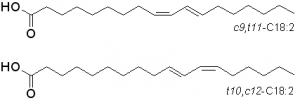Conjugated linoleic acid (CLA) may promote weight loss and support muscle mass, but research is conflicting.

- Reduced fat accumulation. CLA may be able to supress enzymes that promote fat storage.
- Increased fat burning. Another way CLA may promote weight loss is by increasing the amount of fat burned to produce energy.
- Increased lean body mass. Some studies have shown that CLA might increase muscle mass when paired with exercise.
Overview
Conjugated linoleic acid refers to a mixture of linoleic acid isomers. As an isomer, CLA has the same molecular formula as linoleic acid but different structure. The two most frequently used and studied CLA isomers are c9t11 (cis-9, trans-11) and t10c12 (trans-10, cis-12).
Naturally, CLA is produced by fermentative bacteria found in the digestive tract of ruminant animals such as cattle, goats, and sheep. As such, ruminant-derived meat, milk and dairy products, are the predominant dietary sources of CLA. CLA supplements, on the other hand, are typically made from safflower oil, and include a 1:1 ratio of c9t11 and t10c12 CLA.
CLA has been scientifically investigated since the 1980s. Since then, much of the focus has been on its effects on body composition, and particularly the loss of body fat and increase in lean body mass. But while petri dish and animal research has shown promising findings, human trials report contradictory results.

How CLA Might Help With Fat Loss
Given conflicting results of human trials, it’s not entirely clear how CLA might work to affect body fat deposits and fat metabolism. However, researchers suggests two main mechanisms:
Reducing of fat accumulation
CLa may inhibit the activity of lipoprotein lipase, an enzyme that promotes the accumulation and storage of fat. As such, it may result in less new fat being made. 3
Increasing fat oxidation
Several animal and human studies have reported that CLA increases fat oxidation, which results in more fat being used to produce energy. One of the ways it achieves this could be by stimulating carnitine palmitoyl transferase, an enzyme involved in fatty acid oxidation.4 5
CLA’s Potential Fat Loss Benefits
CLA is typically advertised as a fat burner and pre-workout supplement. CLA supplements such as Tonalin are claimed to promote fat loss and increase lean body mass, especially when paired with exercise.
However, the current human data is contradictory; while some studies show that CLA does promote loss of fat with or without exercise, others show no effect. Similarly, studies that combine CLA with resistance training report mixed results on fat loss and muscle mass.
Overall, researchers suggest that CLA supplementation does have a minor fat-burning benefit. However, they do not believe this effect is strong enough have any clinical relevance for weight loss.6 As such, CLA is best seen not as a “miracle pill” but as an addition to a healthy and active lifestyle.

Research
Animal Research
CLA research as a fat loss supplement in animals has been overwhelmingly positive. Specific findings indicate that CLA may:
- Decrease body fat by as much as 43-88% and increase muscle mass7 8 9
- Promote fat loss by increasing the body’s energy expenditure 10
Human Research
Research findings of CLA’s effects on weight and fat loss in humans have been mixed, with some studies showing a benefit, and others reporting no effect. In general, it appears that CLA may promote minor fat loss, but whether this effect is significant enough to warrant supplementation remains open to debate.
CLA (12 g) appears to reduce fat in overweight/obese adults
This randomized, double-blind trial tested the weight loss effects of CLA in overweight/obese adults in specific parts of the body. One-hundred eighteen individuals were given CLA (12 g total) or placebo daily for 6 months. CLA was found to significantly decrease body fat mass (BFM), with most of the fat loss being located in the legs, and also increase lean body mass.
- The researchers concluded that “supplementation with CLA in healthy, overweight and obese adults decreases BFM in specific regions.“11
CLA (3.4 g) does not appear to prevent weight or fat regain after dieting
In a randomized, double-blind trial, 101 obese individuals first underwent an 8-week diet that resulted in >8% weight loss. Then, they were given CLA (3.4 g) or placebo daily for 1 year alongside a modest diet to see if CLA could prevent weight regain. The study did not find any substantial differences in body weight or body fat between the two groups after one year.
- The researchers concluded that “A 3.4-g daily CLA supplementation for 1 y does not prevent weight or fat mass regain in a healthy obese population.“12
CLA (3.4 g) may reduce body fat in overweight and obese people
In this randomized, double-blind trial, the effect of CLA on body fat mass (BFM) was determined in 60 overweight or obese volunteers. Study subjects were divided into five groups receiving daily placebo or, 1.7, 3.4, 5.1 or 6.8 g of CLA, for 12 weeks. CLA-treated groups showed significantly higher reduction in BFM than placebo. The largest loss of fat was observed in individuals supplemented with the 3.4 and 6.8 g of CLA.
- The researchers concluded that “CLA may reduce BFM in humans and that no additional effect on BFM is achieved with doses > 3.4 g CLA/d.” 13.
CLA (1.8 g) appears to promote fat loss in regularly exercising individuals
In a double-blind, randomized trial, researchers investigated how CLA supplementation (1.8 g) or placebo for 12 weeks would affect 20 exercising individuals of normal body weight. The study subjects exercised in a gym for 90 min three times weekly. The amount of body fat was substantially reduced in the CLA-treated group, but not in the placebo group. However, no changes of body weight were detected in both groups.
- The researchers concluded that “CLA reduces body fat but not body weight in healthy exercising humans of normal body weight.“ 14.
CLA (3 g) may slightly decrease body fat in overweight or obese children
In this double-blind, randomized, trial, CLA was studied as a fat-reducing supplement for children. Sixty-two children between 6-10 years old were given either placebo or 3 g/d of 80% CLA in chocolate milk for 7 months. Ir was found that CLA diminished the increase in body mass index (BMI), and helped decrease abdominal fat in particular.
- The researchers concluded that “CLA supplementation for 7 ± 0.5 mo decreased body fatness in 6–10-y-old children who were overweight or obese.“15
CLA (3 g) does not appear to reduce body fat in healthy women
The goal of this randomized study was to see if CLA was effective at burning fat in humans as in animals. Seventeen healthy women were given placebo or CLA (3 g) daily for 64 days while their diet and activity were held constant. There was no significant difference between CLA and placebo in body fat percentage, fat mass, fat-free mass, body weight, fat oxidation, and energy expenditure.
- The researchers concluded that “consumption of a CLA mixture at 1% of calories had no significant effect on body composition or energy expenditure in healthy women after 64 d of intervention.These results are in marked contrast to previous animal studies.“16
Dosage for Fat Loss
- 3 – 3.4 g is the most common dose used by research studies
- Standalone CLA supplements typically come in 1 g capsules, taken 3 times daily
- CLA doses as high as 6 g daily for a year have been shown to be safe
Supplements in Review Says
- CLA, 3 – 3.4 g daily, made from safflower oil.
CLA seems to be a solid addition to exercise and dieting. Although human trials have failed to reproduce the promising results of animal research, CLA does appear to have a mild fat loss benefit, especially when paired with exercise.
Most successful clinical trials use the 3 – 3.4 g dose. This dose is also similar to the one recommended by CLA supplements, which typically provide 1 g of CLA per capsule taken three times daily.
Leave a Reply